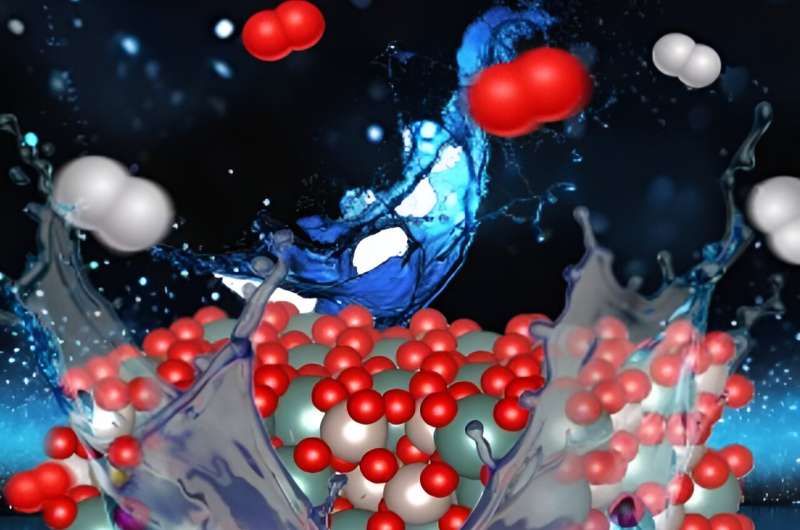This article has been reviewed according to Science X's editorial process and policies. Editors have highlighted the following attributes while ensuring the content's credibility:
fact-checked
peer-reviewed publication
trusted source
proofread
Defect engineering leads to designer catalyst for production of green hydrogen

Efficient technology for splitting the hydrogen–oxygen bond in water could be the key to producing low-cost, green hydrogen for energy storage at an industrial scale. Green hydrogen is expected to play a significant role in achieving the U.S. Department of Energy's target of net zero carbon dioxide emissions.
In a new study published in the Journal of the American Chemical Society, an interdisciplinary group of researchers have identified a way to use "defect engineering" to significantly boost catalytic efficiency, taking science one step closer to sustainable, green hydrogen production.
Clean hydrogen can be produced using solar and wind energy through electrochemical reactions from water. In a typical device, known as proton exchange membrane electrolyzer, water molecules are broken down into hydrogen and oxygen gases at two electrodes using electricity: Hydrogen gas is harnessed at one side (cathode), and oxygen is released as the only by-product at the opposite electrode (anode).
One of the challenges of the current process is that while hydrogen gas can be generated quickly, oxygen gas is produced much more slowly. This limits the flow of the electrical current—and gas production—because the overall production is limited by the slow part of the reaction.
In this project, the researchers designed a new complex oxide material to serve as a catalyst for the electrolyzer to speed up the generation of oxygen. This advancement, in turn, is expected to lead to a more efficient flow of electric current and higher production rate of green hydrogen.
Led by chemical and biomolecular engineering professor Hong Yang, the researchers used ruthenium to form the base of a new complex oxide electrocatalyst with a pyrochlore mineral structure. They employed a technique called defect engineering to alter the electronic structure of ruthenium by partially introducing yttrium to the reactive site.
"Instead of creating a perfect solid, introducing a number of atoms as 'defects' to the reactive site allows us to create a better catalyst," said Yang.
Though unusual in the design of electrocatalysts, defect engineering is common in computer chips: "impurities" are added to silicon, which improves the performance. Without trace amounts of other atoms, silicon by itself does not work well or at all, Yang explained. The team was able to use this approach to explore the effect of different compositions of an electrocatalyst on reactivity and stability of the electrode for the generation of oxygen gas.
They showed that replacing a certain number of ruthenium atoms with yttrium boosted the oxygen generation activity. Using a tool called thermogravimetric analysis, they were able to quantify how much oxygen vacancy was created in the electrocatalysts with different compositions and, in turn, determine what role the oxygen vacancy and metal elements played in the improved activity.
"Initially, I expected that the oxygen concentration in the molecule might increase, and that may have an effect on the performance," said Bidipta Ghosh, a graduate student in chemical engineering and the paper's first author. "But surprisingly, we saw that in our material the quantitative value of the oxygen remained constant, and it was the oxidation state that got changed."
"One cannot just randomly create a less-perfect material and expect improved performance," Yang said. "Just like in silicon chips, the level and type of imperfections in an electrocatalyst must be carefully controlled. We not only identify what we should do, we also figure out to what degree we should do it to achieve the maximum activity."
The team was able to experimentally identify the kind of electronic configuration change of ruthenium that created the enhanced reaction activity. They showed that in this process, excess yttrium in the ruthenium site are primarily balanced by the change of electronic charges on active atoms, while the amount of missing oxygen atoms is unchanged in the electrocatalysts.
In other words, yttrium optimized the performance of the electrocatalyst through changing the electronic structure of ruthenium, without impacting the number of missing oxygen atoms.
To reach these conclusions, Yang said that the interdisciplinary nature of the team was essential in allowing them to overcome several technical challenges in characterization. "The success of this work is only possible through close collaborations with our able experts in related fields," said Yang.
More information: Bidipta Ghosh et al, Defect Engineering in Composition and Valence Band Center of Y2(YxRu1–x)2O7−δ Pyrochlore Electrocatalysts for Oxygen Evolution Reaction, Journal of the American Chemical Society (2024). DOI: 10.1021/jacs.4c04292
Journal information: Journal of the American Chemical Society
Provided by University of Illinois at Urbana-Champaign




















